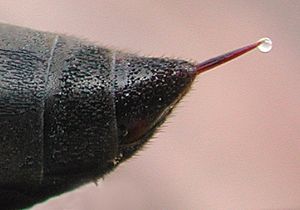Stinger facts for kids
A stinger is a sharp body part found on many animals. It is also called a sting. These animals, like insects and other arthropods, use their stinger to inject venom into another animal. They usually do this by poking through the skin.
When an insect stings, it often puts venom into the body. Not all stings have venom, though. People sometimes confuse stings with bites. Bites can also put things like saliva into the body.
Venom can cause an allergic reaction in some people. This can make the skin itchy or swollen. Sometimes, it can cause bigger skin problems. The pain from a sting depends on where it is and what insect stung you. It also depends on how sensitive you are.
Many bees and wasps have two glands that make venom. One gland makes a mild poison. The other makes a different kind of poison. When these two poisons mix during a sting, they become much more irritating. For a few people, a second bee or wasp sting can cause a very serious allergic reaction called anaphylaxis.
Most insects pull their stingers out after stinging. But some leave their stinger behind. For example, honey bees have a barbed stinger. It gets stuck in the skin of mammals. This means the bee cannot pull it out and dies. Most wasps have smooth stingers and can sting many times. Some other animals, like scorpions, also sting.
Animals with Stingers

Many arthropods have a stinger. This is a sharp body part often connected to a venom gland. It is used to hurt by piercing. Stingers are usually found at the back of the animal. Animals like bees, wasps (including hornets), and scorpions have stingers. There is even one type of beetle, Onychocerus albitarsis, that can sting with its antennae! Its antennae look like a scorpion's tail.

Honey bee workers have special stingers. Their stingers have strong barbs. When a honey bee stings a mammal, the stinger gets stuck. It tears away from the bee's body, and the bee dies in minutes. The stinger keeps pumping venom into the victim. This helps protect the bee's hive from large animals. The stinger also leaves behind a special smell that warns other bees. Honey bees can sting other insects without dying. This is because insect skin is not as stretchy as mammal skin.
Most other bees and stinging animals have stingers without strong barbs. This means they can sting many times without dying. Some wasps, like yellowjackets, do have tiny barbs on their stingers. But these barbs are so small that the wasp can often pull its stinger out.
Some wasp venoms contain a substance called 5-HT. This substance helps cause pain. It also helps the venom spread quickly in the victim. This helps to quickly stop the animal that was stung.
It's important to know that spiders only bite, they do not sting. However, some tarantulas have special barbed hairs that can irritate. Some caterpillars also have these irritating hairs. Centipedes also bite with modified front legs, they do not sting.
Other Animals with Similar Organs
Some other animals have body parts that work like stingers. For example, stingrays have a modified spine on their tail that can inject venom. Male platypuses have venomous spurs on their back legs. Jellyfish have special stinging tentacles called cnidocytes.
The word "sting" was sometimes used for a snake's fang in the past. But today, we say snakes bite, they do not sting.
See also
- Bee sting
- Cnidocyte
- Chelicerae
- Forcipule
- Insect bite
- Schmidt Sting Pain Index
- Starr sting pain scale
- Stinging plant


